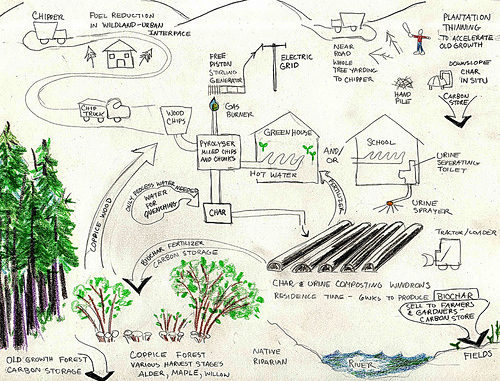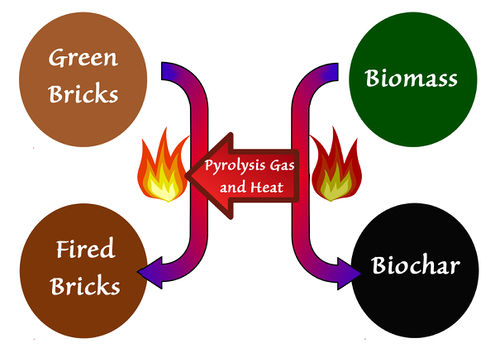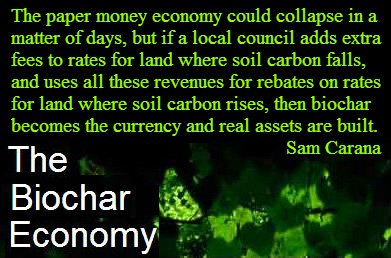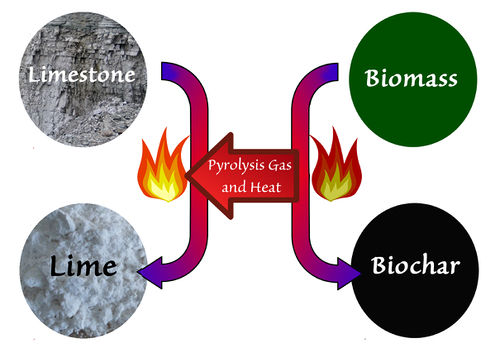The Biochar Economy: Difference between revisions
m (→Related Products: + link) |
(Added some more information) |
||
| (4 intermediate revisions by 2 users not shown) | |||
| Line 31: | Line 31: | ||
* for efficient biochar transport over long distances: [[Aerial_Ropeways#Open_source_ropeway_hardware_for_large-scale_biochar_transport|aerial ropeways]]; also see: [[DroneKite]] | * for efficient biochar transport over long distances: [[Aerial_Ropeways#Open_source_ropeway_hardware_for_large-scale_biochar_transport|aerial ropeways]]; also see: [[DroneKite]] | ||
* [[Troy Martz Gasifier]] - gasifies charcoal | * [[Troy Martz Gasifier]] - gasifies charcoal | ||
* [[Direct Carbon Fuel Cell]] | |||
* [[Bone Char]] - not biochar but has similar production process, therefore easily integrated (another co-product) | * [[Bone Char]] - not biochar but has similar production process, therefore easily integrated (another co-product) | ||
* Biochar can be part of a [[Biofilter]] (similar to [[Wood Chips]]) | |||
* Many machines to get biochar into the soil, such as [[Spader]], [[Microtractor]], [[Rototiller]], etc. | * Many machines to get biochar into the soil, such as [[Spader]], [[Microtractor]], [[Rototiller]], etc. | ||
* Related process - [[Hydrothermal Carbonization]] | * Related process - [[Hydrothermal Carbonization]] | ||
* [[Activated Carbon]] / [[Granulated Activated Carbon]] (Related materials used for Filtration and/or Selective Adsorption Concentrators) | |||
==Future Dedicated Wiki== | ==Future Dedicated Wiki== | ||
| Line 45: | Line 48: | ||
[[File:Biochar Economy quote.jpg|left|391 px|thumb|Quote was found on the [http://biochareconomy.blogspot.ca/2014/08/biochar-builds-real-assets.html Blog "The Biochar Economy"]. It is an example of how financial and regulatory matters can also be aspects of the biochar economy.]] | [[File:Biochar Economy quote.jpg|left|391 px|thumb|Quote was found on the [http://biochareconomy.blogspot.ca/2014/08/biochar-builds-real-assets.html Blog "The Biochar Economy"]. It is an example of how financial and regulatory matters can also be aspects of the biochar economy.]] | ||
[[Category:Biochar]] [[Category: Enterprise]] ? (most likely rural/developing areas with little fuel/electricity infastructure) | |||
Latest revision as of 21:58, 12 October 2025

Concept: Broadly, this refers to various products and processes dealing with biochar, either in its production, transport or end use. Biochar is a carbon-negative product, i.e. its production takes carbon out of the atmosphere and puts it into a form that is stable in soil for a long time ("recalcitrant"). This is an exothermic process: while it does not yield as much energy as full gasification or combustion, it still gives off a lot of useful energy. The idea behind the "Biochar Economy" is to try to embed biochar production into other processes (e.g. co-production, see below). This may or may not make economic sense, depending on the market price achievable for biochar and carbon removal from the atmosphere. If the price for biochar and carbon negativity is very low, then this is less efficient and too expensive, considering only the energy yield per unit of biomass.
Co-Production Concepts

Co-production can can mean that the energy/heat released during the biochar process is integrated with another process. Examples include:
- Direct reduced iron (turning iron ore into iron using pyrolysis gases, e.g. in a rotary kiln)
- Biochar/brick co-production system
- Biochar-lime co-production system
- Biochemicals from pyrolysis
- Biochar and Bioasphalt (see: biorefinery)
- Nitrogen fertilizer from pyrolysis gas: the Eprida process
- Electricity: pyrolysis oil micro-refinery where the gaseous and light fraction of distillates powers a combustion engine
Related Products
- Kon-Tiki Kiln - open source kiln that produces very clean biochar
- Biochar Crusher - to pulverize biochar
- Biochar as a Building Material
- steam powered wood chipper
- open source steam weeder
- The "Charvester" - a biochar producing tractor
- for efficient biochar transport over long distances: aerial ropeways; also see: DroneKite
- Troy Martz Gasifier - gasifies charcoal
- Direct Carbon Fuel Cell
- Bone Char - not biochar but has similar production process, therefore easily integrated (another co-product)
- Biochar can be part of a Biofilter (similar to Wood Chips)
- Many machines to get biochar into the soil, such as Spader, Microtractor, Rototiller, etc.
- Related process - Hydrothermal Carbonization
- Activated Carbon / Granulated Activated Carbon (Related materials used for Filtration and/or Selective Adsorption Concentrators)
Future Dedicated Wiki
The number of applications for such a new ecomomy is vast. Therefore, a dedicated wiki is needed. Many pages could be transwikified from the OSE wiki, from Appropedia and Wikipedia. Any interested participants please step forward, contact Rasmus Kiehl.
Links
- Climate CoLab entry (2011): "Carbon-negative biochar economies"
- Facebook group: The Biochar Economy
- Blog "The Biochar Economy"
- Slideshare presentation by Rasmus Kiehl (2010): "Combining Biochar and Microfinance for Carbon Offsets"

? (most likely rural/developing areas with little fuel/electricity infastructure)
